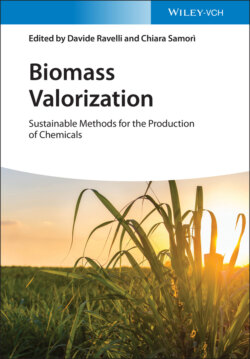Читать книгу Biomass Valorization - Группа авторов - Страница 17
1.6 Pretreatment of Lignocelluloses
ОглавлениеPretreatment is a necessary measure for handling biomass on an individual component basis. One of the main functions for pretreatment is to facilitate separation and allow for improved access of the different biomass fractions, particularly from the rigid components that make up the plant wall [75]. In lignocellulose, these rigid components that significantly hinder solubilization are lignin and cellulose. Peculiarly, the separation of each bio‐component without further decomposition (e.g. to by‐products) could greatly contribute to the development of efficient conversion strategies, improving the competitiveness of a bio‐economy.
Biomass pretreatments can be classified as physical, chemical, physicochemical, or biological [75–77]. Physical pretreatment is reserved mainly for less complex applications where only an increased surface area is mostly desired. Some common physical pretreatment methods are sheer mixing, milling, and grinding that physically break apart the plant wall components [76]. Chemical pretreatment is widely used for its ability to greatly improve solubilization in order to make subsequent biomass processes possible. Chemical methods include acid/alkali treatment, ozonolysis, and organosolv [77]. Many researchers have been utilizing acid treatment as a simple chemical transformation route that is particularly useful for releasing some of the bio‐sugars that are locked behind the more rigid components. Furthermore, if the targeted reaction is acid‐catalyzed dehydration of the sugars to furanics or levulinics, the plausible residual presence of acids may only enhance the rate of said reaction. On the other hand, most biological treatments are safe and green processes that utilize fungi or other microorganisms. The enzymes break down hemicellulose and lignin rather well, while leaving intact cellulose. However, biological processes proceed at rather slow rates and the microorganisms typically only thrive in a fine‐tuned aqueous environment. A majority of the innovative pretreatment methods fall under physicochemical, as many benefits from the combinatory approach. These combination treatments include steam explosion, ammonia fiber expansion, carbon dioxide explosion, and wet oxidation with steam explosion being one of the most used. Steam explosion uses high‐pressure steam that creates a self‐reacting autohydrolysis environment for transforming biomass mechanically and chemically [25].
With current progress, pretreatment is a necessary measure for processing lignocellulosic biomass. The lignin content is largely responsible for complicating the heterogeneous nature of lignocelluloses and for contributing recalcitrant properties that make it difficult to handle. Without pretreatment, most valorization approaches are not cost effective [78].
Ideally, a pretreatment step would efficiently separate lignocellulose into its single components. If this is achieved, biomass processes could be standardized (based on each component) to greatly alleviate the issues of biomass inconsistency. It would also contribute to optimized processes that maximize process conditions such as yields and overall costs. When contemplating biocatalytic conversion of biomass (e.g. yeast fermentation), typical yields are low (<20%) without pretreatment. This phenomenon is given by the barrier effect of lignin to enzyme, physically hindering the hydrolysis of the digestible components (i.e. sugars) [79,80]. Improvements of product yields have been obtained with either biological [81], physical [82], and chemical steps [78,83] or physicochemical [84,85] pretreatments, thus giving higher resource efficiency. Cost‐effective solutions would ideally remove lignin without affecting the desired carbohydrates, hence being energy effective while having a simple reactor design and low production of waste compounds (including solvents) [86]. Nevertheless, improvement of the current pretreatment technologies is still required to obtain economical solutions. Various pretreatment strategies and their advantages and disadvantages are illustrated in Table 1.2.
Overall, different pretreatment methods will be preferred for different applications. For example, applications requiring low toxicity would be better suited with microbial conversions. Alternatively, applications requiring high sugar yields would probably utilize chemical conversions. The main challenge for selective biomass processes is achieving a reasonable balance between cost considerations and efficient separation of each component. In addition, pretreatment requirements with current technologies further complicate the processes [87]. Innovative solutions that address these challenges will help push biomass processes closer to practical implementation.
Table 1.2 Advantages and disadvantages of pretreatment methods for lignocelluloses.
| Method | Pretreatment | Advantages | Disadvantages |
|---|---|---|---|
| Biological | Fungi | Energy effective | Low hydrolysis rate |
| Degrades lignin/hemicellulose network | |||
| Physical | Milling | Reduces cellulose crystallinity | Energy intensive |
| Chemical | Ozonolysis | Lignin reduction | Cost ineffective (ozone) |
| Low microbial inhibitors | |||
| Organosolv | Lignin and hemicellulose hydrolysis | Big solvent volumes | |
| Requires solvent recycle | |||
| Alkali | Lignin removal | Inefficient for softwoods | |
| Large amounts of water | |||
| Reduces cellulose crystallinity | Long pretreatment times | ||
| Limited hemicellulose degradation | Base recycle | ||
| Concentrated acid | High glucose yield | Large amounts of acids | |
| Energy effective | Requires acid recycle | ||
| Reactor corrosion | |||
| Diluted acid | Low microbial inhibitors | Low sugar yields | |
| Lower corrosion issues | Degradation products | ||
| Ionic liquids | Reduces cellulose crystallinity | Cost ineffective (ionic liquids) | |
| Higher accessible surface area | Difficult recovery/separation of desired products | ||
| Lignin removal | Potential toxicity and thermal instability of ionic liquids | ||
| Degrades lignin/hemicellulose network | |||
| Physicochemical | Steam explosion | Lignin removal | High microbial inhibitors |
| Hemicellulose solubilization | |||
| Fair sugar yields | Partial hemicellulose degradation | ||
| Economical | |||
| Ammonia fiber expansion (AFEX) | Higher accessible surface area | Inefficient with lignin‐rich biomass | |
| Low microbial inhibitors | Big ammonia volumes (cost) | ||
| CO2 explosion | Higher accessible surface area | No effect on lignin/hemicelluloses network | |
| Low microbial inhibitors | High pressure (cost, reactor) | ||
| Economical | |||
| Wet oxidation | Lignin removal | Cost ineffective (oxygen and alkaline catalyst) | |
| Low microbial inhibitors | |||
| Energy effective |
